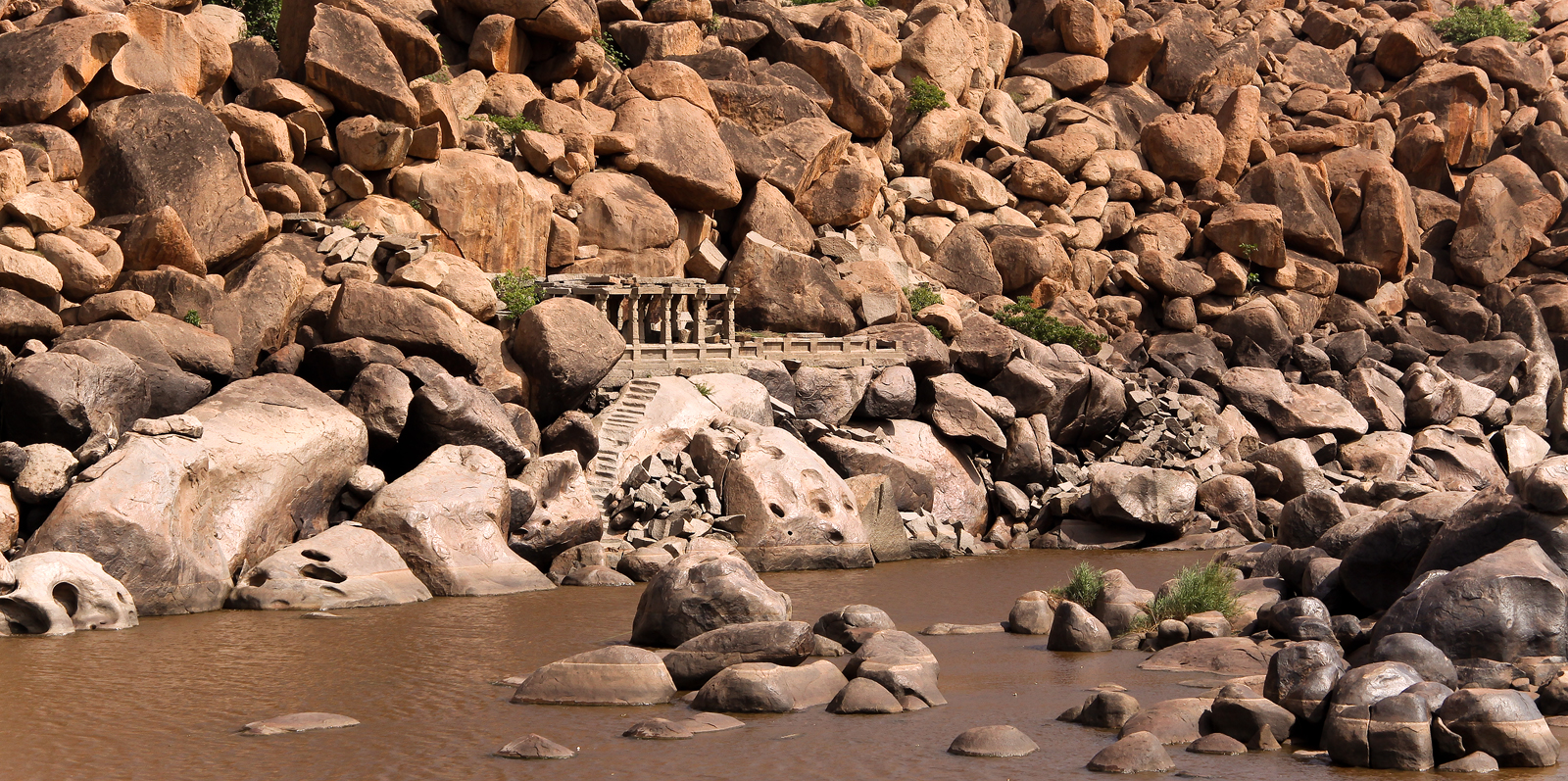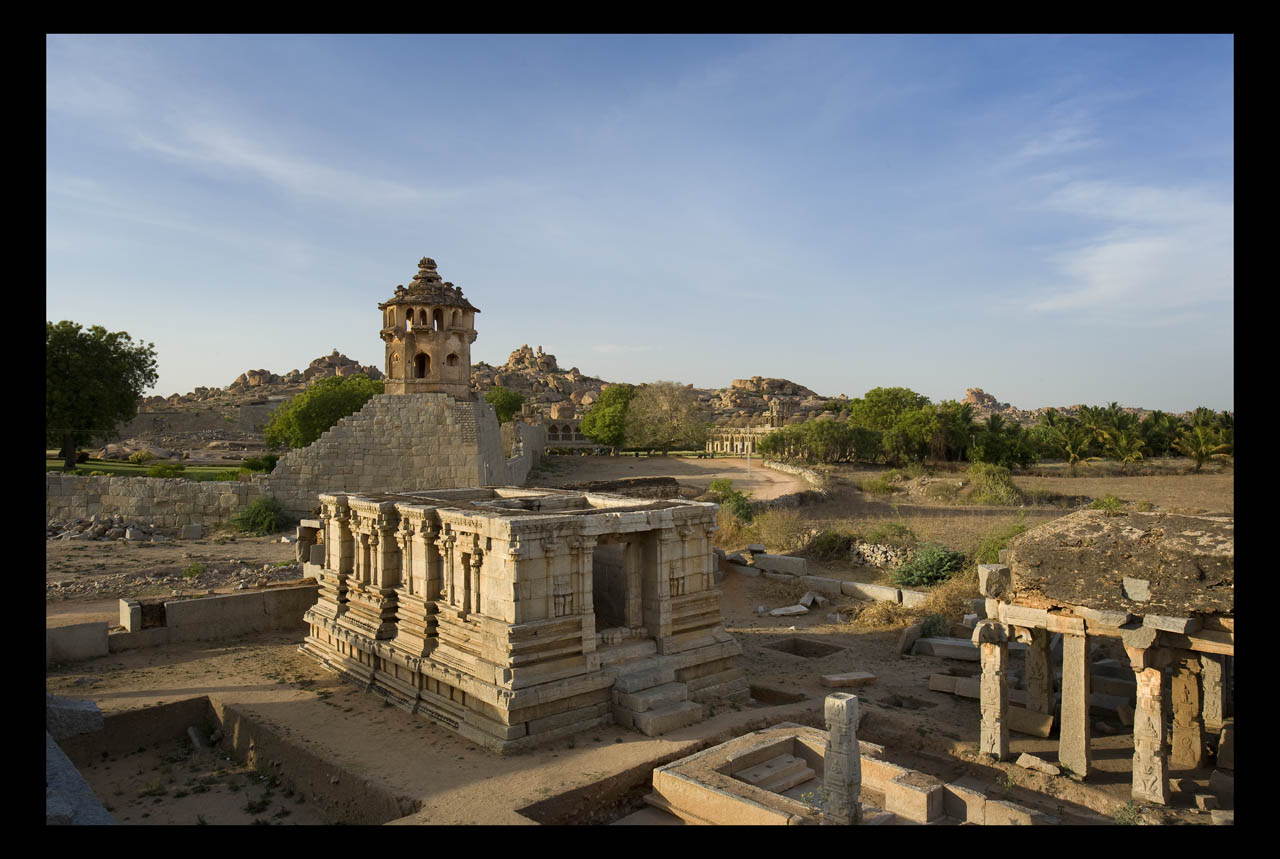| Destination: Hampi |
| Destination Type: History, Arts & Culture |
| City: Hampi-Hospet |
| Country: India |
- By Air : The Nearest Airport is Bangalore Airport 185 kms
- By Rail : The Nearest Railway Station Hospet
- By Road : State transport buses and private luxury coaches connect various centres
From atop the Matanga Hill at daybreak, Hampi is every inch the capital city of a golden empire. Though what lies before are but the bones of an enchantress, who once had the whole world in her sway, Hampi is far from what one would call ruins. Once visited by the Portuguese, Arabs, Persians and Orientals, the capital city of Vijayanagara, has only grown in popularity across the centuries. And no surprise that! Every bend in the road is punctuated by a 14th century, if not older, temple; perched on nearly every hillock is a four-pillared canopy-like monument and its entire horizon, pixilated by huge gestalt-ish boulders. The regal 9-storey tall gopura of the Virupaksha Temple, where Siva is believed to have married Parvati, watches over the city like a specially-appointed god - its memory of magnificence and grandeur forever etched in stone.
Hampi gives an impression of preserving itself for the past to resume. The wedding ceremony of Shiva and Parvati is celebrated every year at the Virupaksha Temple, as it has been for centuries. The long bazaar avenues stand in expectant silence, as if waiting for that kind of commerce to resume, where diamonds and precious stones were used as currency. In the evenings, like a zillions dusks before, the dying rays of the sun turn the entire Vijaya Vittala Temple to gold; a sight which is as much a wonder as the temple's 56 musical pillars that produce the sounds of 56 different musical instruments. The Royal Enclosure waits in readiness for its sandalwood halls to be returned, the massive elephant stables, the Lotus Mahal - shaped like a lotus blossoming in the sun, the Hazararama Palace temple with intricate stories carved over its every side and the Mahanavmi Dibba or the Victory Platform still majestic and proud await to fall back into routine. The sheer detail of the carvings and the number of sculptures speak of a race of artisans that weren't quite done in their business of outdoing each other in craftsmanship. Monolithic structures carved out of a single rock - the imposing Lakshmi Narasimha, the majestic Stone Chariot, the massive Ganesha statues, the Badavilinga are proof of the brilliance that was once envied. Cross the Tungabadra River over to the ancient capital of Anegundi and there are leisurely roads to traverse, myths to chase and boulders to scale and dive off, into the waiting arms of the Sanapur Lake.
Hampi has challenged time, survived the centuries and lived to tell the tale. And, they say, if you listen carefully enough, you might learn a thing or two on how to do the same.
- The Virupasha Temple : The temple of virupaksha , an aspect of Shiva and the guardian deity of the Vijayanagara Kings, rises majestically at the western end of a 700 m long street, once the site of the famous Hampi bazaar. The temple is entered through a 50 m tall, elaborately carved gateway that may have belonged to an earlier period and is believed to have been renovated in 1510 by the empire's most famous ruler, Krishna Deva Raya. Inside is a series of calm courtyards dotted with small shrines and pillared halls, some of which date back to the first Vijayanagara rulers. The hall outside the central shrine is richly carved and has ceiling paintings with scenes from Hindu mythology and the Shaiva Puranas. The shrine itself, still in use, contains the worship of nearly five centuries of devotees.
- The Narasimha ,The Shibalinga & the Ganesha Monoliths : These idols are in themselves temples. The gigantic 8 - 9 m tall Narasimha image is situated in the South of the Hemakuta group of temples that includes the Virupaksha Temple. The Narasimha is a seated four armed figure under a canopy of a seven hooded snake. Though in a damaged state, the image depicts the benign aspect of the God since apart of the right hand of Goddess Lakshmi skirts around the waits of Narasimha suggesting that goddess Lakshmi was originally seated on his lap. The monolith is disfigured but is magnificence is undisputed.The Shivalinga is situated next to the Narashimha and is again, gigantic in size. It is 3m high and stands permanently in water that comes through an ancient channel.The two Ganesha images are on he slopes f the Hemakuta hill. One of the them is enclosed in a temple with unusually tall pillars, the other is in an open hall. The Sasivikalu Ganesha (Sasivi-mustard, Kalu-Grain) stands 2.4m tall without shoes. The Kadalai Kalu Ganesha (Kadalai0gram) is 4.5 m high. The Vijayanagara empire obviously had its jesters!
- The Vithal Temple : The Vithala temple is situated on the southern bank of the Tungabhadra river and is generally considered the most splendid of the religious monuments at Hampi. Its reputation is well deserved; both in he variety of styles that characterise the shrines within the temple courtyard and in the fineness of the carving that embellish them. Hard granite has been persuaded to sway, to flow, to rise up in columns so that the texture of the stone itself seems to have changed and become elastic. The main pavilion contains 56 pillars, each of which has been carved out of a single granite block in a rich structural unit with a cluster of slender colonettes raised on crouching animals. When struck, some of these columns give out musical notes as though from different percussion instruments. The Vithala temple also contains a magnificent stone chariot that houses the mythical eagle, the Garuda.The carving is delicate and the engineering so superb that the stone wheels can even revolve. The brick super structure on top of the chariot is sadly no longer in existence.
- The Lotus Mahal : Of the non religious buildings in Hampi, probably the most photogenic, is the Lotus Mahal. This graceful two-storied pavilion is located in what is known as the 'Zenana' enclosure. The palace is delightful synthesis of the Hindu and Islamic styles of architecture very different from the awesome grandeur of Hampi's temples. The building is an open pavilion on the lower level and built up with windows and balconies on the upper level. What gives the palace its name are its beautifully recessed archways set in geometric regularity and opening out to the sun and the wind like the petals of a flower.Another example of Indo-Saracenic architecture at Hampi are the Elephant Stables, a row of eleven chambers which once housed the magnificent beasts. The long facade of the building with its arched entrances and many domes-octagonal, fluted and plain-make it an imposing edifice.Very close to the Lotus Mah
- Visit Kaladham, Matanga Hill, Monkey Temple

